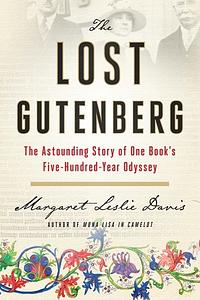You need to sign in or sign up before continuing.
Take a photo of a barcode or cover
33 reviews for:
The Lost Gutenberg: The Astounding Story of One Book's Five-Hundred-Year Odyssey
Margaret Leslie Davis
33 reviews for:
The Lost Gutenberg: The Astounding Story of One Book's Five-Hundred-Year Odyssey
Margaret Leslie Davis
The writing is in the present tense, which sounds weird. I found this book interesting although somewhat padded.
Though Margaret Leslie Davis's book is centered around a copy of the famous Gutenberg Bible (designated Number 45), it's really about the people who have sought, owned, and studied it over the course of two centuries. After a short description of the book's origins in the 15th century, she picks up the story with Archibald Acheson, 3rd Earl of Gosford, who purchases the book in 1836. While her reasons for starting with him go largely unmentioned (she does reference the book's previous owner, a Henry Perkins), the earl's purchase occurred at a time when the rare book market had emerged and copies of such books were increasingly prized by the growing group of collectors. As Davis notes, though, the Gutenberg was initially not as greatly valued as other works, with the earl acquiring his prize for a surprisingly modest sum.
That would change over the course of the 19th century, as the Gutenberg Bible became increasingly prized for its beauty, its rarity, and its historical significance. Davis charts this development through a succession of owners, from the earl through Lord William Tyssen-Amherst (who added the volume to his collection in 1884) to Charles William Dyson Perrins (a condiment manufacturer) before the book's eventual purchase by the wife of an American oil tycoon, Estelle Doheny, in 1950. As she traces the course of its ownership, she describes the motivations of each collector, their various views of the Bible, and their treatment of the book, all of which she makes engaging with a fine appreciation for engaging details. The increasing reverence in which the book is held is perhaps best embodied by Doheny, who upon her death donated it and the rest of her extensive collection to St. John's Seminary in Camarillo, California. This is where Davis tells what is perhaps the most tragic part of the book's tale, for upon the expiration of the restriction on Doheny's donation the Roman Catholic Church sold the Bible along with most of the other books and artwork she gifted them.
Today the Gutenberg Davis describes resides in a vault at Keio University in Japan, where it remains physically inaccessible to the public. Yet Davis ends the book on a surprisingly optimistic note, as she describes how, thanks to digitization efforts, anyone on the Internet today can read Number 45 for themselves, as digital scans of it are online at http://dcollections.lib.keio.ac.jp/en/gutenberg. Hopefully Davis's book will encourage more people to visit the site to see this historical treasure for themselves, especially given the winding journey it took to go from closeted collections to readability by the world.
That would change over the course of the 19th century, as the Gutenberg Bible became increasingly prized for its beauty, its rarity, and its historical significance. Davis charts this development through a succession of owners, from the earl through Lord William Tyssen-Amherst (who added the volume to his collection in 1884) to Charles William Dyson Perrins (a condiment manufacturer) before the book's eventual purchase by the wife of an American oil tycoon, Estelle Doheny, in 1950. As she traces the course of its ownership, she describes the motivations of each collector, their various views of the Bible, and their treatment of the book, all of which she makes engaging with a fine appreciation for engaging details. The increasing reverence in which the book is held is perhaps best embodied by Doheny, who upon her death donated it and the rest of her extensive collection to St. John's Seminary in Camarillo, California. This is where Davis tells what is perhaps the most tragic part of the book's tale, for upon the expiration of the restriction on Doheny's donation the Roman Catholic Church sold the Bible along with most of the other books and artwork she gifted them.
Today the Gutenberg Davis describes resides in a vault at Keio University in Japan, where it remains physically inaccessible to the public. Yet Davis ends the book on a surprisingly optimistic note, as she describes how, thanks to digitization efforts, anyone on the Internet today can read Number 45 for themselves, as digital scans of it are online at http://dcollections.lib.keio.ac.jp/en/gutenberg. Hopefully Davis's book will encourage more people to visit the site to see this historical treasure for themselves, especially given the winding journey it took to go from closeted collections to readability by the world.
An absorbing and moving story. From the creation of the Bible’s to their time on the internet, you learn a lot about the books themselves. You also learn about the people and their various motivations to collect and the triumphs and tragedies along the way

